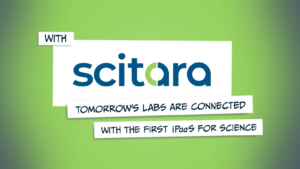In previous blogs, we explored the concept of Composable Architecture and how Scitara DLX can extend it into the laboratory setting. In this blog, we’ll examine how Scitara DLX was implemented in a bioprocess development facility to establish a “Composable Architecture” and develop several applications to manage and enhance the upstream bioreactor development process.
Before delving into the example, let’s simplify the upstream bioprocess to make it accessible to those not involved in bioprocess. The production process for protein-based drugs generally involves a genetically modified organism designed to overproduce the desired protein. A bioreactor is seeded with the organism and carefully maintained over several days or weeks. Throughout this period, internal probes and periodic sampling monitor the bioreactor. The samples are taken to an analytical lab for further analysis. The results are used to control reactor conditions or determine when the reaction is complete. While this might seem straightforward, complexities arise when managing a large bioprocess development experiment.
Our customer’s process was typical. When everything proceeded normally, the operator monitored the bioreactor control panel, adjusted reactor conditions, and took samples every few hours. Analytical results were then recorded in a common spreadsheet. However, when problems arose, tensions mounted as operators scrambled to regain control of the bioprocess. A more consolidated, real-time view of the bioprocess was desired for several reasons:
- Enhanced decision-making through a consolidated view of data updated as soon as analytical data was produced
- Reduction of transcription errors in reporting analytical data
- A cloud-accessible location for data aggregation, viewing, and access, allowing more stakeholders to participate in control and analysis of the bioreactor process
Though the customer did not specifically request a “Composable Architecture,” they expressed the need for a data management platform that allowed users to easily create automations, notifications, or analysis models. Some examples included:
- Receiving notifications or remotely viewing the bioreactor status if certain conditions were met
- Creating an online portal for off-site customers to monitor the bioprocess status
- Establishing a repository of control actions and bioreactor data for AI/ML-assisted bioreactor control
Scitara Digital Lab Exchange (DLX) was ideal for this use case. DLX integrated all upstream bioprocess technologies, enabling orchestration creation to automate workflows or data collection. In the absence of an ELN or LIMS system, DLX also provided a means for user input.
An example orchestration facilitated bioreactor sampling by guiding users through a QR code to make selections or provide data where needed. Once initiated, the orchestration completed several steps, including communicating with the bioreactor controller, creating a record in a DLX datastore, pushing sample details to controlling applications, and adding sample information to the online spreadsheet.
Automation ensured that data was immediately available when a sample was analyzed. An orchestration aggregated sample and result information with other bioreactor data, with a cloud-based spreadsheet serving as the central repository for easy sharing, referencing, and analysis.
In addition to aggregating periodic sample analysis data, an orchestration also automatically captured bioreactor conditions and appended them to the online spreadsheet.
Once all analytical instruments were connected and the orchestrations were created, the composed application was tested during the next bioreactor project. Although some minor issues and improvements were noted, the real-time aggregated view of bioprocess data was a significant enhancement. Users began creating orchestrations for additional data monitoring and analysis.
Following success in the upstream bioreactor area, DLX will be expanded to cover other customer lab areas, including process chromatography and downstream analytics laboratories. The customer’s IT support team has been trained in DLX connector deployment and application/orchestration creation. This enables them to expand the Composable Architecture without significant assistance from Scitara.
As a result, the implementation of Scitara DLX and the development of a Composable Architecture within the bioprocess development facility streamlined data management, improved decision-making, and facilitated user-driven customization. By empowering users to create automations, notifications, and analysis models tailored to their needs, the Composable Architecture has led to increased efficiency, more accurate data, and enhanced collaboration among stakeholders.
The success of this project not only demonstrates the value of a Composable Architecture in bioprocess development. It also highlights the potential for similar approaches to be adopted across various laboratory settings. As more organizations embrace this innovative data management platform, we can expect to see improved communication, data accessibility, and overall efficiency in labs worldwide.
In summary, the integration of Scitara DLX and the establishment of a Composable Architecture have greatly improved the bioprocess development facility’s operations. By enabling users to access real-time data, automate workflows, and create customized applications, the Composable Architecture has proven to be an asset for laboratories seeking to optimize their processes and increase overall efficiency.
